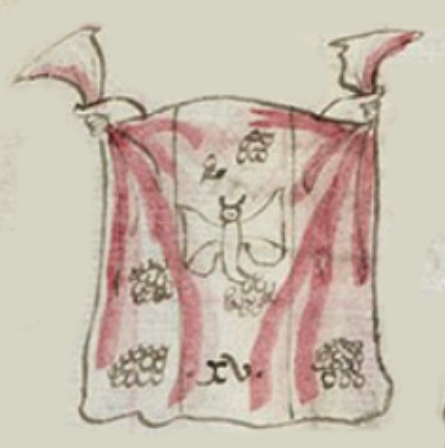tilmatli (CST38)
This painting of the simplex glyph for the term tilmatli (blanket) shows a frontal view of a rectangular piece of fabric that is held in the upper corners by human hands. The symbols on the blanket refer to its use for hatching the eggs of female moths that were a part of the silk-making process. In fact, a moth appears in the middle, surrounded by clusters of eggs.
Stephanie Wood
The companion text not only refers to the tilmatli, but also to the term zotl, which is also a piece of cloth. For more on the Codex Sierra, see Kevin Terraciano’s study (2021), especially p. 81.
Stephanie Wood
1550–1564
Jeff Haskett-Wood
seda, mantas, huevos, gusanos, silk industry

tilma(tli), cloak, cape, blanket, https://nahuatl.wired-humanities.org/content/tilmatli
tilma
Stephanie Wood
Códice Sierra-Texupan, plate 38, page dated 1561. Origin: Santa Catalina Texupan, Mixteca Alta, State of Oaxaca. Kevin Terraciano has published an outstanding study of this manuscript (Codex Sierra, 2021), and in his book he refers to alphabetic and “pictorial” writing, not hieroglyphic writing. We are still counting some of the imagery from this source as hieroglyphic writing, but we are also including examples of “iconography” where the images verge on European style illustrations or scenes showing activities. We have this iconography category so that such images can be fruitfully compared with hieroglyphs. Hieroglyphic writing was evolving as a result of the influence of European illustrations, and even alphabetic writing impacted it.
https://bidilaf.buap.mx/objeto.xql?id=48281&busqueda=Texupan&action=search
The Biblioteca Digital Lafragua of the Biblioteca Histórica José María Lafragua in Puebla, Mexico, publishes this Códice Sierra-Texupan, 1550–1564 (62pp., 30.7 x 21.8 cm.), referring to it as being in the “Public Domain.” This image is published here under a Creative Commons license, asking that you cite the Biblioteca Digital Lafragua and this Visual Lexicon of Aztec Hieroglyphs.







